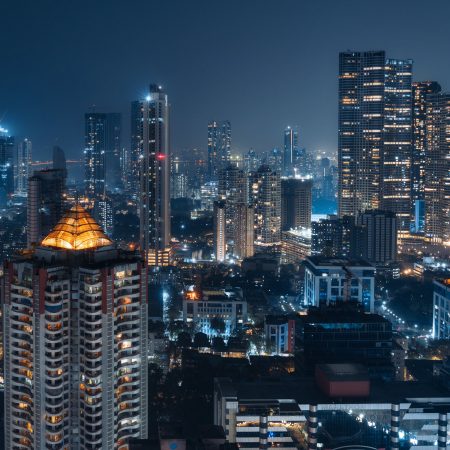Global dispersion of talent
The Savills Future Workforces index analyses over 900 locations around the world based on their performance across seven categories* using current and forecast data to 2033
Source: Savills Research using Oxford Economics, World Bank, UN, SpeedTest, Transparency International, QS, and Numbeo. *Categories: Employment (current and forecast), Population (current and forecast), Economy (current and forecast), Regulatory environment (current), Lifestyle (current), Education (current), Resilience (current)
New ways of working, increased use of technology and emerging industries and locations have transformed the global working landscape over the past decade.
In this new environment, the global workforce is more geographically diversified than ever before – with altered needs and desires. So where can companies and organisations find the skilled employees they need?
The Savills Future Workforces Index shows that talent today is clustering in a range of locations across the world. Some of these are traditional centres for skilled workers, such as Tokyo, New York, Los Angeles and London. Others, such as Delhi, Shanghai and Jakarta, are in laterstage emerging markets, while centres such as Kigali and São Paulo show clustering is happening in the Global South, too.
The picture is complex, reflected in the range of variables that make up the index. An increasingly mobile workforce, which may pursue a remote or hybrid working pattern, may give greater priority to quality of life than before, making this a key criterion. And factors like gender equality also influence the position of centres in the index.
Global workforce comparisons
The biggest challenge of the Future Workforces index, and any global index, is to compare like with like. For this reason, it comprises five complementary indices. The headline index includes all countries, while the other four cover countries in different income segments as defined by the UN: high income (developed markets including countries such as the US, France and Japan); upper middle income (countries such as China, Indonesia and Brazil); lower middle income (the likes of India and Vietnam); and low income (mainly
sub-Saharan Africa).
Across these segments, the fundamental criteria for success are broadly the same, but can sometimes be offset by other factors. A large and growing working-age population is a plus, for example, but where that doesn’t exist higher net migration can compensate. Economic growth is crucial, but so too is a strong and stable regulatory environment, which may be harder to find in very high-growth emerging economies.
Leading centres across the indices offer a balance of attributes. The most successful locations have high growth in the numbers of both white-collar and blue-collar jobs, for example. This means that, while the presence of top universities is a significant plus, overall educational attainment – especially the number of people completing some form of post-secondary education – is vital too.
THE FUTURE TALENT TOP 10
1 Tokyo
2 New York
3 Seoul
4 Shenzhen
5 London
6 Delhi
7 Los Angeles
8 Shanghai
9 Melbourne
10 Manila
Source: Savills Research
Remote working and freedom from geography
Technology has the potential to open up talent pools in hitherto inaccessible markets – especially if combined with remote working. This frees both workers and companies from their geographical locations.
Africa, which has struggled to increase productivity over the past five years, could potentially benefit the most. One in three people entering the workforce will reside in Africa by the 2030s. Attracted by this demographic dividend, international investors are targeting the continent. Centres such as the special economic zone of Kigali, home to BioNTech’s first vaccine manufacturing plant in Africa, show what is possible.
Japan remains at the forefront of technological developments, which have the potential to revolutionise its automotive industry and supercharge economic growth. The country is also using technology in innovative ways to mitigate ageing – through developments such as medical devices and “carebots” – while its fertility rates are projected to surpass those of its East Asian peers. Tokyo, which tops the Workforces Index, scores well for economic strength, regulation and quality of life, so continues to attract young talent.
Meanwhile, China is facing a shrinking workforce and is investing in automation and digitalisation to mitigate that. As its population ages, China is concentrating on modernising traditional industries and producing higher-value goods.
Across the world, from Kigali to Tokyo, the workforce is continuing to evolve. Flexibility is the watchword. This is reflected in real estate trends, with demand rising for new types of office space and housing in the emerging workforce clusters.
India: youth in abundance
With a young population – the average age is 29 – and strong economic growth, India is poised to provide one-quarter of the world’s incremental workforce over the next decade, according to consultancy firm EY. UN estimates show that India has already overtaken China as the world’s most populous country. As China’s population ages and its economy slows, India is set to become the world’s third largest economy in the next few years.
“India is benefiting from a demographic dividend,” says Arvind Nandan, Managing Director, Research & Consulting, at Savills Mumbai. “Urban areas will be the main beneficiary and the long-term challenge for India is to manage migration from rural to urban areas.”
These factors have propelled Delhi to sixth place in the Workforces Index, ahead of many locations in higher-income countries. Other crucial components in the India story are rising household incomes and the doubling of capital expenditure as a share of GDP over the next decade.
“Funds are flowing into infrastructure, especially green infrastructure, which is expected to grow by 500% over the next decade,” says Nandan.
Saudi Arabia: eyeing foreign investment
In a bid to diversify its economy away from oil and attract foreign investment, Saudi Arabia introduced a Regional Headquarters (RHQ) programme on 1 January 2024. The RHQ obliges companies that want to bid for government contracts to base their regional headquarters in Saudi Arabia.
The goal is to attract 480 multinational companies to the country by 2030. Additionally, Saudi Arabia hopes to increase foreign direct investment (FDI) to 5.7% of GDP by 2030. Already, 180 companies have registered, exceeding the initial target of 160.
“The strategy appears to be effective in increasing investor confidence and economic activity,” says Ramzi Darwish, Head of Kingdom of Saudi Arabia, Savills. “The recently announced 30-year tax relief for RHQs acts as a compelling incentive to attract international companies.”
An increase in office demand, particularly from international players, further underlines the Kingdom’s potential, according to Darwish. Nearly 78% of enquiries in the fourth quarter of 2023 came from international companies, with US corporations accounting for 40% of total demand.
As the Saudi economy becomes more international, it is also modernising. “With the introduction of the RHQ and as part of the broader Saudi Vision 2030, companies across different sectors have catered to working mothers,” says Darwish. “Some of the office developments in Saudi Arabia are making it a priority to include a daycare centre as part of their amenities.”
The United States: older, wiser and in need of migrant workers
The US workforce is becoming older, more diverse and better educated. The number of workers aged 65 and over has increased by 117% in the past two decades, while the ratio of women to men in the workforce is heading for parity. The workforce is also becoming smaller, with lowered participation rates, meaning immigration is vital for talent acquisition.
Structural changes, such as greater demand for IT to support remote working, are influencing where the workforce is located. A growing emphasis on education and skills development – including AI skills – is strengthening the knowledge economy to the benefit of innovation hubs such as New York, Los Angeles, Dallas, Houston, Boston, Chicago and San Jose.
“With a flight to quality, tier-one cities with strong knowledge workers, talent pipelines and diverse populations have remained competitive in attracting and retaining top talent by occupying modern offices that focus on ESG metrics and provide wellness amenities,” says Amy Fobes, Senior Vice-President, Global Occupier Services at Savills US. To flourish, both workers and companies need to embrace the changes that remote working and AI have brought to the US jobs market.
“Companies cannot wait around for a return to normal or to understand what their competitors are doing to attract or retain talent,” says Fobes. “A new normal has emerged where the competition for talent is continuing to increase throughout an interconnected global economy. There is an awareness across all executive decision-makers that they must leverage market specific socio-economic indicators and labour data to understand how to capitalise on their brand differentiators, financial objectives and unique metrics for success. Every organisation, even companies within the same industry, has different drivers for success.”

AI: a force for good?
AI is a key influence on the future workplace and the diversifying global talent clusters shown on the map. This year’s Future of Jobs report shows that 75% of companies plan to adopt AI technologies by 2027, while 80% plan to accelerate automation in the same period.
However, scare stories about humans becoming redundant appear to be overstated. Nearly half (49%) of respondents to a World Economic Forum survey expect AI to create jobs. There is a strong argument that AI will be a productivity tool that augments human performance, rather than a replacement for human input.
Used constructively, AI even has the potential to flatten inequalities across the world. In developed economies, it can help compensate for an ageing workforce, while in emerging markets, it can fill medical and educational gaps. This can help developing economies leapfrog stages of development. The widespread adoption of mobile phones in emerging economies, which has catalysed their development to this point, will only become more significant now that they provide the gateway to AI technologies as well. This is, of course, dependent upon network coverage, which is why mobile broadband is a factor in the Index.
Of course, ironing out inequalities through AI requires judicious distribution of the technology. If people able to use AI come to replace those who can’t, AI could deepen inequalities. Investment in infrastructure and education in the developing world is therefore essential to ensure workers there are not left behind.
International Monetary Fund research shows that AI solutions in the developing world must also fit the local context and culture to succeed.



